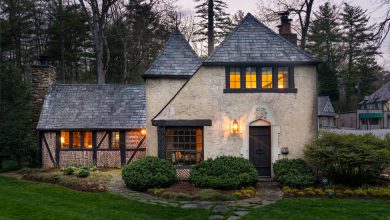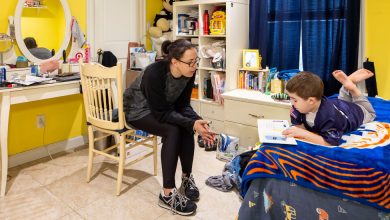Do I Really Need a Toilet?

It’s the height of the pandemic, and I’m looking for an apartment for the first time in 17 years. Some things never change: Finding a place in Lower Manhattan is hard if you’re not fabulously wealthy.
I have just seen a 150-square-foot studio on West Fourth Street for $2,000 a month, and am told that I could save space by hanging my winter coat in the building’s stairwell. “It’d probably be safe there,” the agent reassures me.
He then takes me to a “duplex” around the corner, a ground-floor cell with a menacingly steep spiral staircase that empties into a windowless basement. “$2,300,” he tells me. “Better snap it up. Won’t last.”
I love my sunny Greenwich Village apartment, but Covid has gotten in the way: My theater and teaching work have dried up, my lease is expiring, and the landlord is raising my rent while prices plummet throughout the city. The thought of moving during a pandemic is daunting, and the likelihood of my friends risking infection to help me haul furniture down four flights of stairs is low. On the plus side, for the first time since the Clinton administration, I may be able to afford a decent apartment without leaving the comforts of Lower Manhattan.
In late 2020, I see an amazing apartment on Carmine Street. Amazing is a relative term, of course. This apartment is raw, the designer loved stucco, and the hardwood floors are painted a Brutalist gray. But it is huge: a genuine two-bedroom, with soaring ceilings, tremendous light and unobstructed views of Greenwich Village, all for $1,995 a month. Now that I work from home, the extra space seems positively luxurious. I am ready to make an offer.
The agent, who has described every closet as though he were seeing the Grand Canyon for the first time, pulls me aside at the end of the tour. “Did you notice anything about the bathroom?”
I’m intrigued by his sense of mystery. Was there a bidet I missed? A Jacuzzi tub?
“No toilet.”
Before telling me this, he holds my gaze for a few seconds, as if to say, “A less scrupulous agent wouldn’t disclose this, but I’m leveling with you because that’s the kind of agent I am.” He is proud of himself.
I had actually peeked into the bathroom and noticed the ample tub and sink. I missed the glaring omission, though, as one doesn’t usually notice the lack of things until one needs them. (See: lifeboats/Titanic.)
“No, um, toilet?” is all I can manage. If I weren’t wearing a mask, this would have been a good time for a spit take.
“A lot of people actually prefer it this way,” he assures me. “It’s cleaner.”
I find it hard to believe that there are people who prefer not to have a toilet in their apartment. For the record, this is the only bathroom in the apartment. And the toilet isn’t broken. It simply isn’t there. It never has been. The listing, which mentions that the apartment is near an Equinox and a Starbucks, neglects to mention this.
“So what happens when, um, one needs to use the bathroom?” I ask.
He leads me to a single toilet stall in the hallway and tells me it’s shared by the apartments on the floor. No sink, just a toilet.
This is an old building, and a communal bathroom was common at the time it was built, more than a century ago. I like old things, and appreciate seeing this living history; at the same time, I’m not sure I want to be this intimate with history.
This is a deal-breaker, of course. Or is it? Enormous arched windows. Heart of Greenwich Village. Under $2,000. No storing my clothes in the hallway.
When I get home, I call friends for advice.
My civic-minded friend is in favor of it: “Americans are too isolated in their little bubbles. I support communal endeavors. Besides, most people share bathrooms with family or roommates. You’d only be sharing the toilet.”
Another friend wonders how a romantic interest might react when she asks where the bathroom is and is told to line up in the hall and wait her turn. My friend in the throes of potty training her children offers the extra plastic toilet they keep in the bathroom.
Another friend votes against it, saying earnestly, “You don’t want to be known as the no-toilet-in-his-apartment guy.”
And there are questions: Who cleans the bathroom? How many people live on the floor? Are you sharing it with one other person or 11? If the bathroom is occupied, can you use another floor’s bathroom? Why has this building held out on the in-apartment bathroom conversion, which every other building in New York undertook in, roughly, the F.D.R. administration?
I consult Google on installing my own toilet and learn that this is no simple fix: Not only would I need to connect pipes to the main sewer line — which would require tearing up floors and walls — it would most likely have to be done on every floor, per New York City building codes.
There are a few unorthodox options — there’s something called a macerating toilet that can apparently be hooked up to a regular line — but I decide I don’t want to run an illegal toilet out of my apartment.
I’m tempted to rent the apartment anyway. The communal pool in my childhood neighborhood in Texas made friends of all the neighbors — might this have a similar effect? Imperfect indoor plumbing was good enough for every human being on Earth until about 100 years ago — surely I could get by. I was an ancient history major — this will connect me to the past. I’m an artist — this will keep me humble.
Plus, and this is no small thing, the apartment is twice as large as anything I’ve seen in my price range, and it’s bright and airy, a canvas upon which I could make a great home.
In the end, I decide against it. Two weeks go by, and I’ve seen 10 more depressing apartments, all smaller, with lower ceilings, fewer windows. I check online. The Carmine apartment is now down to $1,850 a month. I think about it. I think about it some more. I check again two days later, and it is in contract. Too late.
I’m starting to realize that most Lower Manhattan places in my price range have a flaw. They would be marked “irregular,” if such a thing existed for apartments.
While a nontraditional space appeals to me — an old warehouse or converted church sounds lovely — the quirks prove more mundane: The attractive apartment on East 12th Street has a stand-alone shower in the living room, promising to make parental visits awkward; the penthouse on West 21st is lit mainly by skylight, with narrow bunker-style windows at eye level, perfect for survivalists or bats. I begin to despair.
But the large two-bedroom on Avenue B is perfect. A corner apartment, drenched in sunlight, it comes with a home office, for a more-than-reasonable $1,895 a month.
I can’t find any faults, so I assume it must be haunted. At this point in my search, I’m fine with that. The street noise can resemble Rio de Janeiro at Carnival, and I fully expect the rent to skyrocket when the lease expires post-pandemic, but I sign on the dotted line.
Not before double-checking the bathroom, though.
Stephen Ruddy, a New York-based writer, can often be found at The Moth and McSweeney’s, and is a creator of the forthcoming scripted podcast, “The Rubber Room.”
For weekly email updates on residential real estate news, sign up here. Follow us on Twitter: @nytrealestate.




